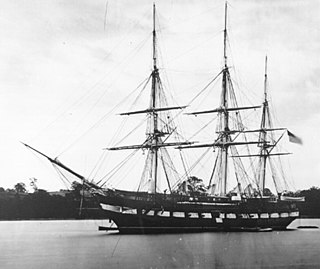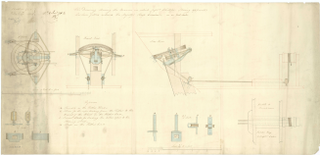
In the 18th century and most of the 19th, a sloop-of-war in the Royal Navy was a warship with a single gun deck that carried up to eighteen guns. The rating system covered all vessels with 20 guns and above; thus, the term sloop-of-war encompassed all the unrated combat vessels, including the very small gun-brigs and cutters. In technical terms, even the more specialised bomb vessels and fireships were classed as sloops-of-war, and in practice these were employed in the sloop role when not carrying out their specialised functions.
Thirteen vessels of the Royal Navy have borne the name HMS Mohawk, after the Mohawk, an indigenous tribe of North America:

The Cherokee class was a class of brig-sloops of the Royal Navy, mounting ten guns. Brig-sloops were sloops-of-war with two masts rather than the three masts of ship sloops. Orders for 115 vessels were placed, including five which were cancelled and six for which the orders were replaced by ones for equivalent steam-powered paddle vessels.
Sixteen ships of the Royal Navy have borne the name HMS Alert, while another was planned:

The Cruizer class was an 18-gun class of brig-sloops of the Royal Navy. Brig-sloops were the same as ship-sloops except for their rigging. A ship-sloop was rigged with three masts whereas a brig-sloop was rigged as a brig with only a fore mast and a main mast.
The Fly class were built for the Royal Navy as a class of 16-gun brig-sloops; an extra two carronades were added soon after completion. The class was designed by one of the Surveyors of the Navy - Sir John Henslow - and approved in 1805. The Admiralty ordered five vessels to this design in January 1805; it ordered two more in the summer, although this final pair were planked with hulls of pitch pine ("fir") rather than the normal oak used in the first five.

The Seagull class were built as a class of thirteen 16-gun brig-sloops for the Royal Navy, although an extra 2 carronades were added soon after completion. The class was designed by one of the Surveyors of the Navy - Sir William Rule - and approved on 4 January 1805. Five vessels to this design were ordered in December 1804; eight more were ordered in the summer.
Thirty-nine vessels of the Royal Navy and its predecessors have borne the name Swallow, as has one dockyard craft, one naval vessel of the British East India Company, and at least two revenue cutters, all after the bird, the Swallow:
Eight ships of the Royal Navy have borne the name HMS Espiegle
The Cyrus-class sixth rates of the Royal Navy were a series of sixteen-flush decked sloops of war built to an 1812 design by Sir William Rule, the Surveyor of the Navy. The first nine ships of the class were launched in 1813 and the remaining seven in 1814. The vessels of the class served at the end of the Napoleonic War. They were built on the lines of HMS Hermes, which was based in turn on the French ship Bonne Citoyenne.

HMS Halcyon (1813) was a Royal Navy Cruizer-class brig-sloop that Edward Larking & William Spong built at King's Lynn and launched in 1813. She had one of the shortest lives of any vessel of her class.
At least four vessels of the Royal Navy have borne the name HMS Leveret.

The Speedy class brigs were a two-ship class of brig built for the Royal Navy during the later years of the American War of Independence. They survived into the French Revolutionary Wars.
The French brig Carlotta was a brig-rigged corvetta-cannoniera or, corvetta-brig, of 10 guns, launched in 1807 at Venice as Fiamma that served the French Navy as Carlotta. HMS Belle Poule captured her in 1810 and the British Royal Navy took her into service as HMS Carlotta. She was wrecked in 1812.

HMS Cruizer was a Snake-class ship-sloop launched in 1828 for the British Royal Navy. The ship was built as a revival of the retired Snake-class ship-sloops. The Navy converted her to a brig in 1831, back to a ship in 1840, and sold her at Bombay in 1849.

HMS Snake was a British Royal Navy ship launched in 1797 as the only member of her class of brig-sloops. She captured or destroyed two French privateers and one Danish privateer. She also captured numerous small merchantmen, but spent time escorting convoys to and from the West Indies. She was sold in 1816.
HMS Busy was launched in 1797 as the only member of her class of brig-sloops. She captured one French privateer and numerous small merchantmen, but spent most of her career escorting convoys to and from the West Indies. She foundered in 1807 while serving on the Halifax, Nova Scotia, station.







